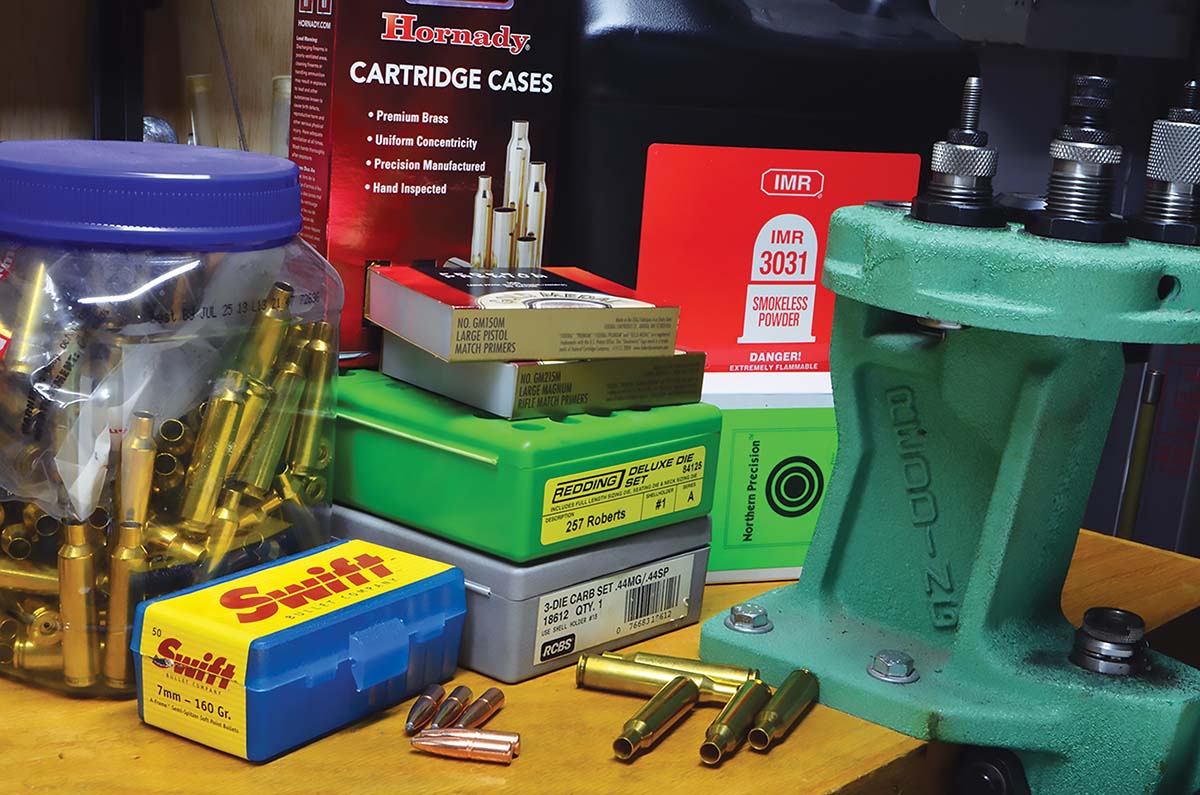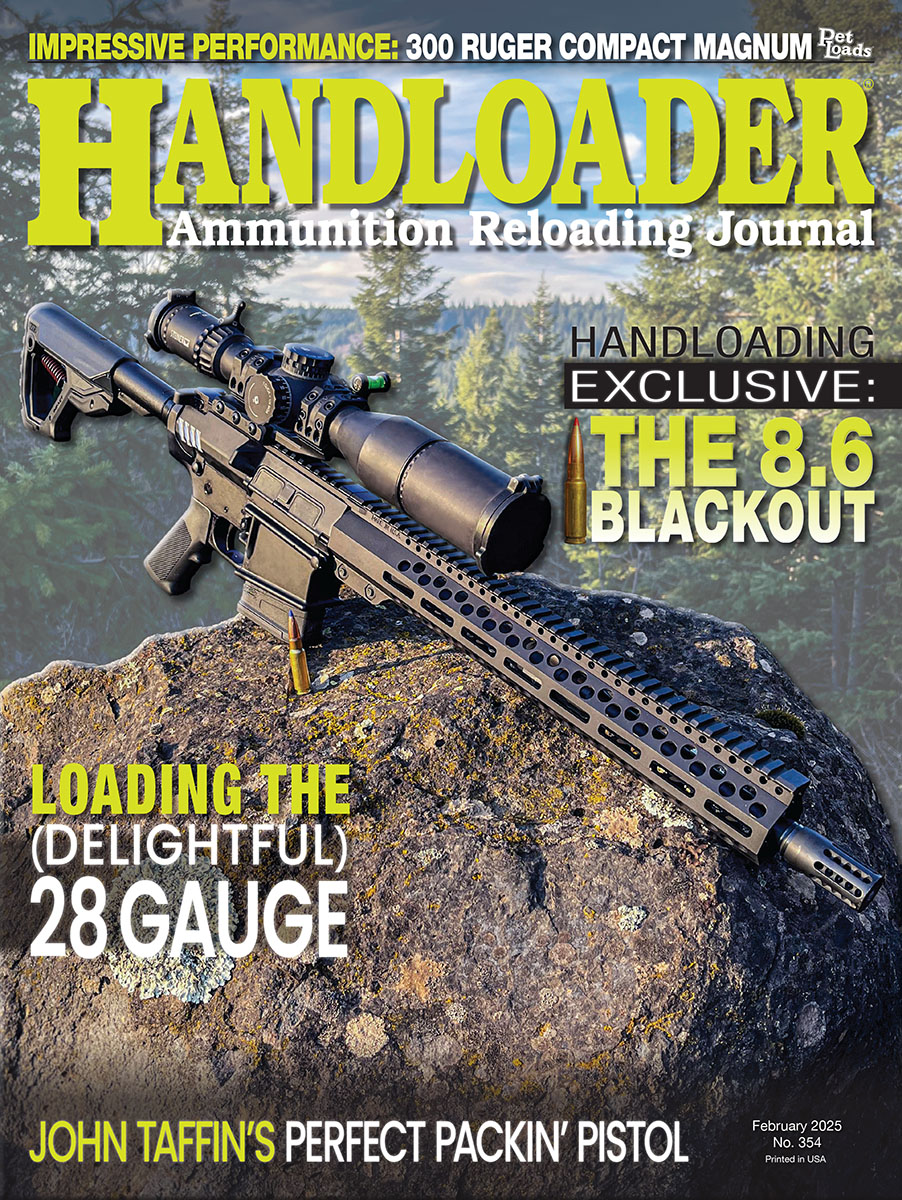In Range
Not Again! (Yes, Again…)
column By: Terry Wieland |

Ever wonder why? I’m here to tell you.
There’s a piece of sage advice you can be given when young, but which you’ll never really accept until you are old, grey and replete with experience. To wit: Seventy-five percent of the things you worry about will never come to pass, and the other twenty-five percent will not be as bad as you expect.
Acceptance of this universal truth comes with having lived through one damn thing after another, many of them several times each, and realizing that we always come out the other side. (Until we don’t, of course, but that’s a topic for another day.)
Recently, I was alerted by phone to the distressing news that “handloading is dying.” Oh? What makes you think that? “Nothing is selling. Equipment is piling up on shelves. We are doomed.” This tidbit took me aback somewhat, as I look around and see shortages almost everywhere, except for loaded ammunition of the most common kinds.
For example, in aid of a future article, I recently began assembling the wherewithal to load .410 shotshells. For this, I wanted a MEC 600 Jr. single-stage press. Ballistic Products, head quarters for all things shotshell, was out of stock; MEC itself listed the .410 600 Jr. as unavailable at the time, with none expected for four to six weeks.
Confronted with this, my friend argued that, since nothing was selling, the factory was not producing any, hence the bare shelves. This struck me as more than passing strange, since MEC’s raison d’être is making shotshell presses. To simply stop making them, instead of stepping up the marketing or having a sale or something, struck even my non-commercial instincts as ridiculous.
A few days later, when requesting some ammunition for testing from one of the major companies, I was advised that times are tough in the industry, with sales down 40 percent. The only bright spot, I was told, was shotshell target loads. Everything else? Dead in the water.
Here, then, we have a situation such as one finds at the confluence of three fast-flowing rivers, with rapids, undertows and water flowing in every which direction. One current pulls downstream while another, right beside it, tries to carry you upstream. One shooting industry symptom suggests one thing, another symptom something quite different.
The internet may contain the sum of human knowledge, and truth may, indeed, be found there, but finding it is akin to looking for a particular bunch of herring three weeks after they’ve been dumped in the Bay of Biscay ten miles off the coast. Good luck.
I tried a search, seeking generic bits of knowledge, and the over-eager algorithms, sensing my interest, immediately inundated me with YouTube videos on everything from gun sales to ammunition surpluses. Of course, I had never heard of the so-called experts offering me their wisdom, in those rare instances where they were identified at all. Out of curiosity, I watched a couple.
One video, purporting to tell which revolvers no one should ever buy, named the Chiappa; another video, advising on what revolvers everyone should have, named the same gun. One video, reporting on the glut of ammunition on the market, gave one reason as a sudden upsurge in handloading, with all of us beavering away, rolling our own and draining the market of components in the process.
To illustrate how knowledgeable these clowns are, one ammunition video persisted in pronouncing Hornady “Hor-NAY-dy,” and instead of saying “twenty-two long rifle,” called it “two-two-ell-arr.” Really?
I gave up on that as a source of enlightenment before what’s left of my brain cells went on strike. Better, I decided to simply rely on my own experience and observations.
Let’s start with experience.
The shooting industry, both guns and ammunition, is subject to periodic booms followed by mirror-image busts. Both typically last a year or two, until the industry either expands to fill demand or reduces production and inventory. Booms are often the result of fear, and the election of a Democrat president is almost always a catalyst. The most recent boom and related severe shortages came from fear of the world ending due to the COVID-19 epidemic. After 2020, millions of new gun owners entered the market. I heard estimates from two to five million, and of course, they all wanted ammunition. Everything became hard to come by. No surprise there.
Seeing this, ammunition manufacturers and importers ramped up supplies just as inflation was starting to bite. Ammunition flooded the market (at least the common calibers like 9mm) but consumer money became tight. Everyone had pretty much stocked up already anyway, and the available pennies were allocated to groceries and car insurance.
To me, this looks like normal economic ebb and flow, and we have not even mentioned the Russian invasion of Ukraine. Suddenly, makers of anything military were either ramping up or diverting production of gunpowder, bullets, brass, primers, all the basic fodder of war.
Even raw materials were affected. Copper prices are the benchmark for metals of all kinds, and as shortages loomed, prices climbed. In 2020, copper was around $1.50 a pound. As I write this (in late July), it is nearing $6.00 a pound. That’s one example, but it’s no wonder ammunition prices are climbing. And when prices climb, guess what happens? People either reduce their buying or stop altogether.
Now back to handloading.
With the huge influx of new gun owners, there was a related surge in interest in handloading, or so we were told, and I believe it with the resulting increase in sales of equipment and components. Seasoned handloaders of a certain age made sure they had enough stuff on hand. In totalitarian states, this is called hoarding and is usually punishable by death; here, we call it strategic thinking and providing for the future. At least I do.
Frankly, I never understood what was wrong with hoarding anyway. Remember the fable about the grasshopper and the ants? I have grasshopper tendencies in some ways, but when it comes to gunpowder, primers, and lead, I am a diehard ant. Why should ants be punished for being prudent, and their supplies seized and handed over to the imprudent? Let ’em starve, I say.
Right now, we have shortages, or in some cases the complete absence, now and into the future, of some gunpowders. This includes all the Alliant products and many of the Hodgdon and IMR numbers sourced in foreign mills now be diverted to war production or rearming the Europeans. Handloaders are scouring shops looking for any lingering supplies, and prices are sky-high.
If we don’t absolutely require the powder, most of us won’t pay the price. We are back to the inflation-tight money equation. Under current world circumstances, I don’t expect powder prices to come down anytime soon, especially given the widely reported shortages of nitrocellulose, a key component. Again, the Ukraine war.
As for the effect of the tariff wars, I have no idea. I know magazine ad managers are being advised of “restructuring” by many clients, which is taken to mean returning production to America. Still, how tariffs affect imports of ammunition, your guess is as good as mine and frankly, I think even the so-called experts are guessing.
The bottom line is, for a shooter to take up handloading is never a bad decision, regardless of shortages, the high cost of components at the time, or the occasional low cost of ammunition. Loading your own means always having what you want versus what’s available. Sometimes, as it did five years ago, it means you having ammunition and being able to shoot when others are staring at bare shelves.
You may save a few pennies, or you may not, but you will always be secure.


